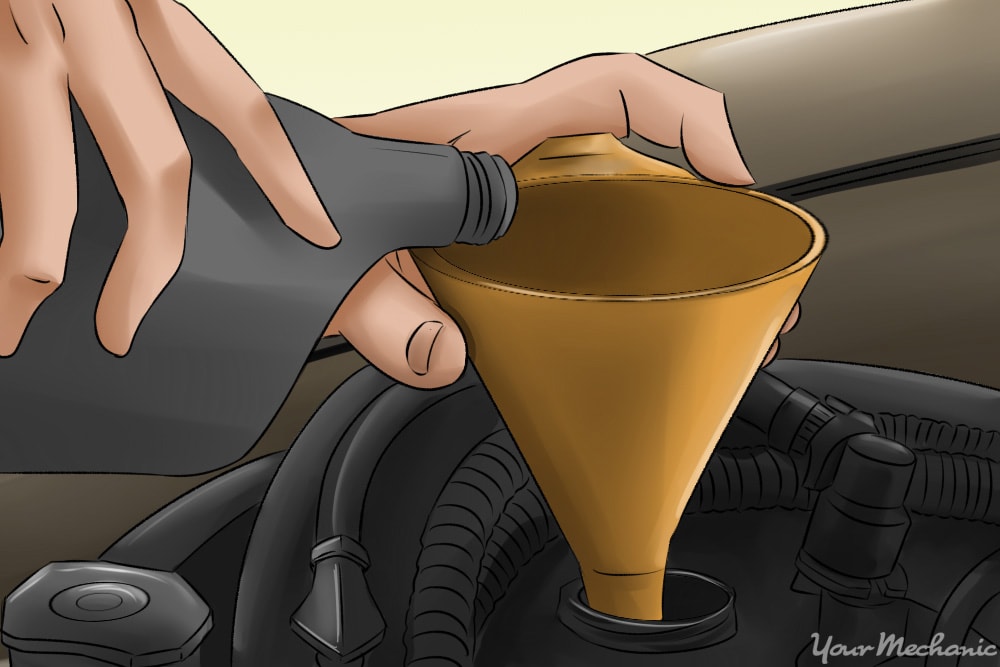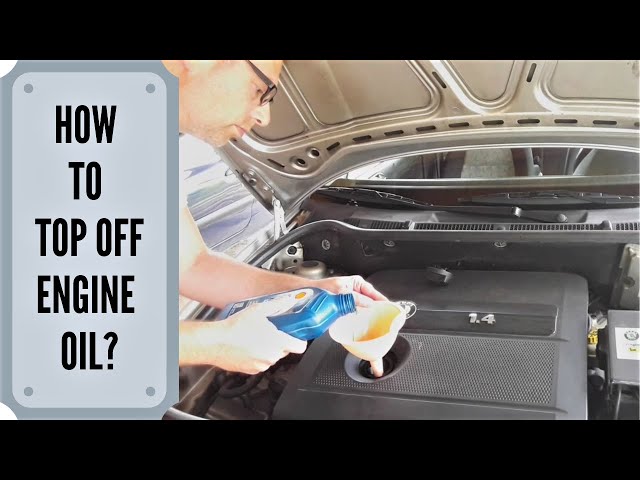How To top off engine oil, first, ensure your vehicle is on level ground and the engine is cool. Open the hood, locate the oil dipstick, and check the current oil level.
Maintaining the correct engine oil level is crucial for your vehicle’s performance and longevity. Regularly topping off your engine oil can prevent mechanical issues and ensure your car runs smoothly. It’s an easy yet important aspect of vehicle maintenance that drivers can manage without much mechanical expertise.
By keeping an eye on your oil levels and topping off as needed, you protect your engine from excessive wear and potential damage. This routine check should be an integral part of your car care regimen, helping to safeguard your engine and maintain its efficiency. Remember to select the right oil type for your vehicle, as specified in your owner’s manual, to ensure optimal engine health.
The Importance Of Proper Engine Oil Levels
Keeping your car’s engine oil at the right level is crucial. It ensures your engine works smoothly. Low oil levels can cause serious harm. Too much oil can also cause problems. Always check your oil regularly to avoid issues.
Risks Of Low Oil Levels
Driving with low engine oil is risky. It can lead to:
- Engine Damage: Parts can wear out without enough oil.
- Overheating: Oil cools the engine. Less oil means more heat.
- Poor Performance: Your car might not drive as well.
- Breakdowns: Severe oil loss can stop your car suddenly.
Benefits Of Adequate Lubrication
Right oil levels keep your engine happy. Benefits include:
- Smooth Operation: Parts move easily with good lubrication.
- Cooler Engine: Proper oil levels help manage heat.
- Less Wear: Oil protects against friction and wear.
- Longer Engine Life: Regular oil checks can extend engine life.

Credit: www.toyotaofclermont.com
Identifying When Your Engine Oil Needs Topping Off
Keeping your engine running smoothly requires attention to its oil levels. Over time, oil can diminish due to use or minor leaks. Knowing when to top off your engine oil is vital for maintaining your vehicle’s health and performance.
Checking The Dipstick
One reliable method to assess oil levels is by using the dipstick. Follow these steps:
- Locate the dipstick under your vehicle’s hood.
- Pull it out and wipe it clean.
- Reinsert the dipstick fully, then remove it again.
- Check the oil level against the marked indicators.
If the oil doesn’t reach the full line, it’s time to add more.
Signs Of Oil Deficiency
Your vehicle might show several signs when it’s low on oil. Watch for these:
- Engine noise: If your engine is louder than usual, it might need oil.
- Oil warning light: A lit-up oil symbol on your dashboard is a direct signal.
- Smoky exhaust: Excess smoke indicates oil might be burning within the engine.
Consistent monitoring and addressing these signs promptly will keep your engine in top shape.
Selecting The Right Oil For Your Vehicle
Selecting the Right Oil for Your Vehicle is crucial for engine health. The correct oil ensures smooth running. It also prolongs engine life. Let’s explore how to make the best choice for your car.
Understanding Viscosity Ratings
Viscosity measures oil thickness. It affects how oil flows in the engine. The right viscosity is essential for proper lubrication. Look at your car’s manual. It will tell you the recommended viscosity. For example, 10W-30 oil has a viscosity rating suitable for a range of temperatures.
Synthetic Vs. Conventional Oil
Synthetic oil is man-made. It works well in extreme conditions. Conventional oil is natural. It is cheaper but may not perform as well. Consider your vehicle’s needs. Think about driving conditions. Choose oil that matches these factors.
| Synthetic Oil | Conventional Oil |
|---|---|
| Higher performance in temperature extremes | Cost-effective for regular conditions |
| Longer change intervals | Frequent changes needed |
| Better for modern engines | Works well with older engines |
Preparation For Topping Off Engine Oil
Preparation for Topping Off Engine Oil is key to maintaining your car’s health. This task requires precision and attention to detail. Below, we detail the initial steps to prepare for this crucial maintenance activity.
Gathering Necessary Supplies
Before beginning the oil top-off process, you must gather all necessary items:
- Engine oil: Check your car’s manual for the correct type and amount.
- Funnel: To pour oil without spilling.
- Clean rag: To wipe any spills and clean the dipstick.
- Gloves: To keep your hands clean and protect from hot surfaces.
- Safety glasses: To protect your eyes.
Ensuring Engine Safety
Engine safety is paramount. Follow these steps:
- Turn off the engine: Allow it to cool for at least 10 minutes.
- Locate the hood release: Usually found under the dashboard.
- Open the hood: Secure it with the hood prop.
- Find the dipstick: This is where you check the oil level.
Ensuring the engine is cool and the car is on level ground is essential for accurate oil level reading.
By following these preparation steps, you ensure a safe and effective top-off of your car’s engine oil.
Step-by-step Guide To Adding Oil
Regularly checking and topping off engine oil is vital for your vehicle’s health. A correct oil level ensures smooth engine operation. This guide will show you how to add oil to your engine with ease.
Locating The Oil Filler Cap
First, find the oil filler cap. It’s on top of the engine. Look for a cap marked with an oil can symbol or labeled “Engine Oil.” Make sure the engine is cool before you touch anything under the hood.
Adding Oil Carefully
Adding oil requires precision. Follow these steps:
- Remove the oil filler cap.
- Insert a funnel into the opening.
- Pour oil into the funnel.
- Fill slowly and check the dipstick.
- Stop when the level is right.
- Replace the cap securely.
Use the dipstick to monitor the oil level. Do not overfill. Overfilling can harm your engine. After adding oil, wipe any spills and close the hood firmly.

Credit: m.youtube.com
Aftercare: Post-top Off Checks
Topping off your engine oil is important, but it’s not the end of the job. To keep your car running smoothly, follow these simple aftercare steps. They ensure your engine has the right amount of oil without any leaks.
Rechecking Oil Level
Wait a few minutes after topping off before checking the oil level again. This allows the oil to settle in the pan. Pull out the dipstick, wipe it clean, reinsert it fully, and pull it out once more to check the level. The oil should be between the two marks. If it’s not, add a little more oil and check again.
Looking For Leaks
After the oil level is correct, look for leaks. Start your engine and let it run for a few minutes. Then, turn it off and check under the car for any signs of oil. Spotting leaks early can save you from future engine damage. Focus on the oil filter and drain plug, as these are common leak points. If you find a leak, tighten any loose parts or replace faulty seals as needed.
Remember, regular checks keep your engine happy and your car running smoothly!
Maintaining Your Engine Oil
Maintaining your engine oil is crucial for your car’s health. Clean oil ensures smooth engine operation and longevity. Let’s explore how you can keep your engine in top shape by focusing on two key aspects: regular oil changes and monitoring oil health.
Regular Oil Changes
Changing your engine oil regularly is essential. It keeps your engine clean and running efficiently. Follow these steps to ensure timely oil changes:
- Check your car’s manual for the manufacturer’s recommended oil change interval.
- Mark your calendar to keep track of oil change schedules.
- Use the correct oil type as specified for your car model.
Regular maintenance avoids major engine problems.
Monitoring Oil Health
Keeping an eye on the condition of your engine oil is key to engine maintenance. Here are some tips to help you monitor your oil’s health:
- Check the oil level once a month using the dipstick.
- Look for any changes in oil color and texture.
- Notice if there is a burnt odor or any metal particles in the oil.
These signs can indicate that your oil needs a change sooner than expected. Regular checks help catch issues early, saving you from costly repairs.
By sticking to these guidelines, you can keep your engine in excellent condition and extend your vehicle’s lifespan.

Credit: www.yourmechanic.com
How to Top Off Engine Oil
1. Check the oil level again to see how much oil is required.
2. Unscrew and remove the oil filler cap.
3. You should then add a small amount of fresh oil, ideally using a long-neck funnel, and then wait a minute or two for it to arrive in the sump.
4. Check the level again using the dipstick, and keep adding oil in small amounts until you are happy with the level.
Check Engine Oil Hot or Cold
Checking your engine oil is crucial for maintaining your vehicle’s health, but when is the best time to do it: hot or cold? For the most accurate reading, check your engine oil when the engine is cold, ideally before driving the car or several hours after parking. It allows the oil to settle in the sump and prevents inaccurate readings due to oil throughout the engine. Remember to park on level ground to ensure the dipstick shows a proper level, keeping your engine running smoothly.
How do you know when you need an oil change?
Knowing when to change your car’s oil is crucial for maintaining its health and performance. Typically, it would help if you considered an oil change every 3,000 to 5,000 miles, but modern vehicles can often go up to 7,500 miles thanks to advancements in oil and engine technologies. Always check your vehicle’s manual for specific recommendations. Signs that you might need an oil change include a louder engine, darker, dirtier oil on the dipstick, and the illuminated oil change light on your dashboard. Regular oil changes keep your engine running smoothly, extending its lifespan and ensuring optimal performance.
Frequently Asked Questions
Can You Just Top Up Engine Oil?
Yes, you can top up engine oil as needed. Always check the dipstick level first and add the correct type of oil gradually, avoiding overfilling.
Is It Okay To Top Off Engine Oil?
Topping off engine oil is acceptable if levels are low. Always check the dipstick first and avoid overfilling, as this can harm the engine. Use the correct oil type for your vehicle.
How To Top Off Oil Correctly?
Check your car’s manual for the correct oil type. Ensure the engine is cool. Remove the oil filler cap. Use a funnel to pour in oil slowly, checking the dipstick level frequently. Stop when it reaches the full mark. Replace the cap securely.
How Do I Top My Car Engine Oil?
To top off your car engine oil, park on level ground and let the engine cool. Pull out the dipstick, wipe it clean, reinsert and remove to check levels. Add oil if below the full mark, wait a few minutes, and recheck to ensure proper fill without overfilling.
Conclusion
Topping off your engine oil is a simple yet crucial task for maintaining your vehicle’s health. By following the steps outlined, you ensure your car runs smoothly and efficiently. Remember, regular checks can save you from costly repairs down the line.
Drive safe and keep your engine happy with timely oil top-offs!
